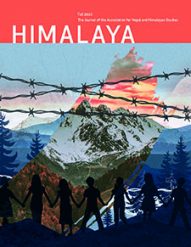Photo Essay
On the Road in Rasuwa, Nepal
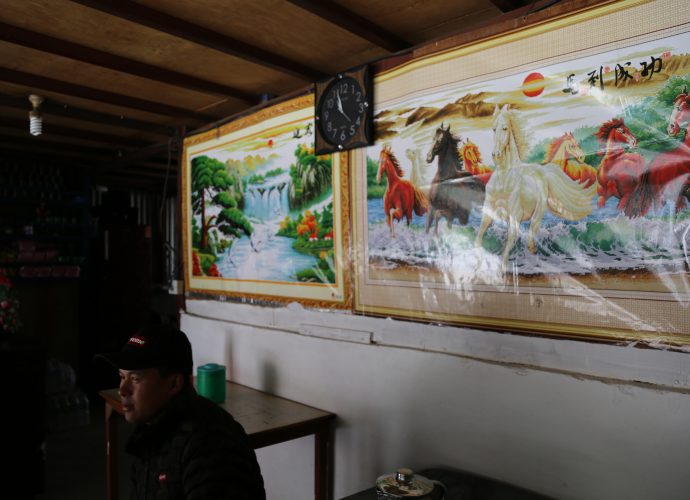
Inside a local eatery, Ghattekhola. Ghattekhola village is approximately one mile south of the Rasuwagadhi border. It used to be a small village with only about a dozen households, but is quickly growing into a vibrant site for trade and other activities along the Rasuwagadhi corridor. Apart from local eateries and hotels catering to the truckers and locals crossing the border, it also houses a temporary immigration office, a border police station, and several motor workshops.
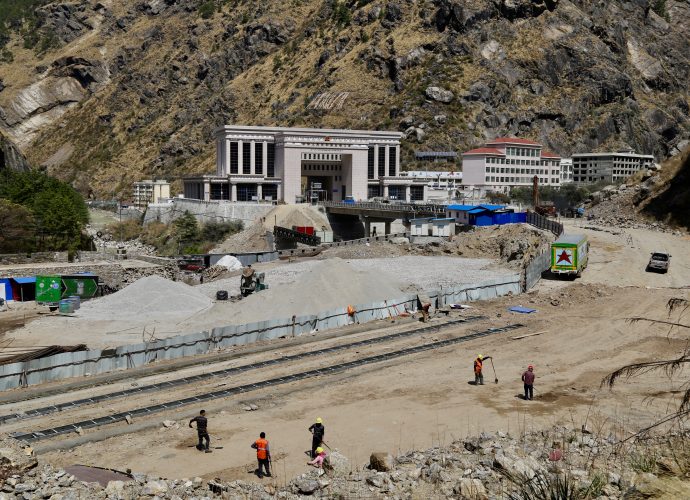
Construction site of the integrated border facilities and check post, Rasuwagadhi. Nepal and China signed an agreement in April 2015 to construct an integrated border facility at the Rasuwagadhi border in Nepal, with the objective of boosting overland trade between the two neighbors, as well as to ease the cross-border mobility of its citizens. According to the agreement, China agreed to provide consultation and financial aid to build a dry port at Rasuwagadhi, near the friendship bridge. The construction of the planned dry port and border facilities began in 2019, nearly four years after the agreement was signed.
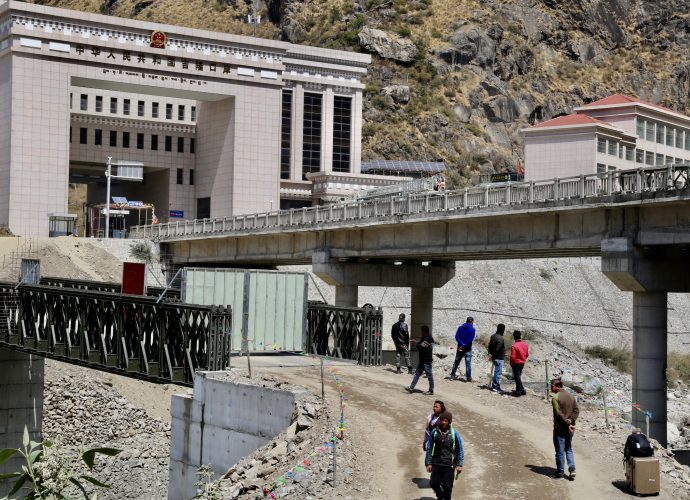
Nepal-China friendship bridge, Rasuwagadhi. The 2015 Nepal earthquake severely damaged the friendship bridge at Rasuwagadhi. A landslide triggered by the earthquake further damaged the bridge. Vehicles currently use a military-style portable refabricated truss bridge installed below the ravaged old bridge, which is under construction.
![Rasuwa custom office, Timure
After the closure of the Tatopani-Kodari border corridor in the aftermath of the earthquake, Rasuwa became Nepal’s only cross-border corridor with China. Despite poor road infrastructure made worse by recurrent landslides, and import driven trade of Nepal, the custom office at Timure has been relatively ‘successful’ in meeting revenue collection targets set by the Department of Customs over the years. In March 2019, the chief customs officer informed us during a visit to the region that the Timure customs office was successful yet again to meet a set target of Rs. 9 billion [approximately 80 million USD] in revenue within eight months. According to a media report, “the highest revenue, Nepali Rupees 2.32 billion [approximately 20.48 million USD], was recorded in September-October when imports soared due to demand fueled by Dashain and Tihar festivals”. Despite generating large revenues from Rasuwa, the revenue collected goes straight to the national treasury.](../../wp-content/uploads/2019/10/Rasuwa.4-690x500.jpg)
Rasuwa custom office, Timure After the closure of the Tatopani-Kodari border corridor in the aftermath of the earthquake, Rasuwa became Nepal’s only cross-border corridor with China. Despite poor road infrastructure made worse by recurrent landslides, and import driven trade of Nepal, the custom office at Timure has been relatively ‘successful’ in meeting revenue collection targets set by the Department of Customs over the years. In March 2019, the chief customs officer informed us during a visit to the region that the Timure customs office was successful yet again to meet a set target of Rs. 9 billion [approximately 80 million USD] in revenue within eight months. According to a media report, “the highest revenue, Nepali Rupees 2.32 billion [approximately 20.48 million USD], was recorded in September-October when imports soared due to demand fueled by Dashain and Tihar festivals”. Despite generating large revenues from Rasuwa, the revenue collected goes straight to the national treasury.

Chinese visitors cross towards Nepal on the Friendship Bridge, Rasuwagadhi. According to Nepal’s Department of Immigration statistics, Chinese nationals register as the highest percentage of tourists in the first four months of 2019 at nearly 65,000, a 20% increase from the previous year. According to the same report, more than 25,000 Chinese tourists entered Nepal through Rasuwagadhi alone. However, according to local hotel owners, these tourists only passed through Rasuwa and hardly spent time or money in the district.
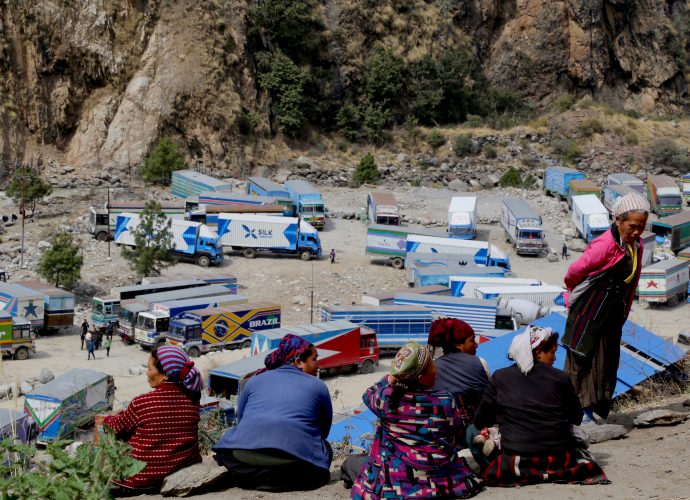
A group of local women working as porters at the border overlook a truck parking lot at Timure. A large number of local residents currently work in Timure truck park where they transport imported good after they clear customs. They are mostly from Timure, but also include locals from neighboring villages such as Thuman, Khangjim, Bhirdim, Chilime, Gatlang, among others. There are also people from outside Rasuwa district who work as porters in Timure. According to one of our interlocutors, Timure truck park employs the greatest number of locals from the region despite the hard work it requires. Often, locals from the neighboring villages rent a small room in Timure during the peak season when it is more profitable. The majority of the people working in the park are primarily women, and toddlers can often be seen playing around as their mothers move goods.

Nepal China border citizen entry/exit pass. With the development of road infrastructure and the formalization of trade between Nepal and China, Rasuwa residents have more interactions with state agents and bureaucracy. In the past, residents were not required to have a border pass to cross the border. However, since the signing of the Sino-Nepal boundary agreement in 1960, border citizens have to apply for Nepal-China border entry/exit passes. Only residents of Rasuwa district are eligible for this border pass to cross the Rasuwa-Kerung border.
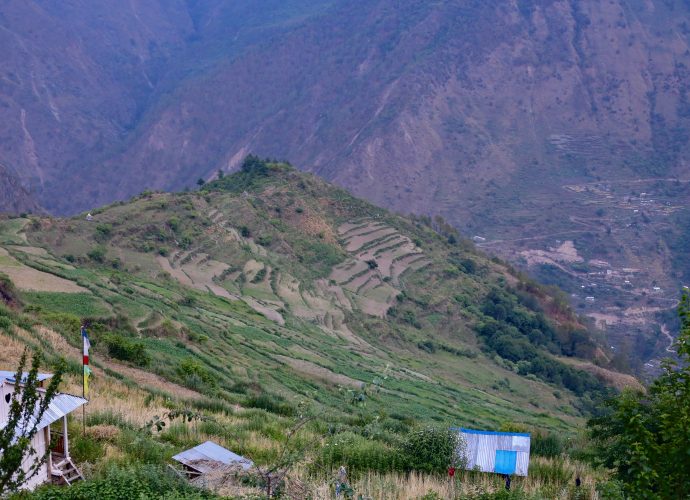
Rice fields, Thuman. Nepal has seen a rapid decline in agricultural work due to outmigration to urban areas, as well as to the Gulf states and Malaysia for manual labor. Villages of Rasuwa have experienced a similar trend, undermining subsistence agriculture despite a local refrain in the village of Thuman—suun ra nuun bhayek sabai kura falcha— ‘that everything except salt and gold grows in Thuman.’ The (re)opening of the border and subsequent increase in trade has not changed the farming situation, although many residents now work within the district.
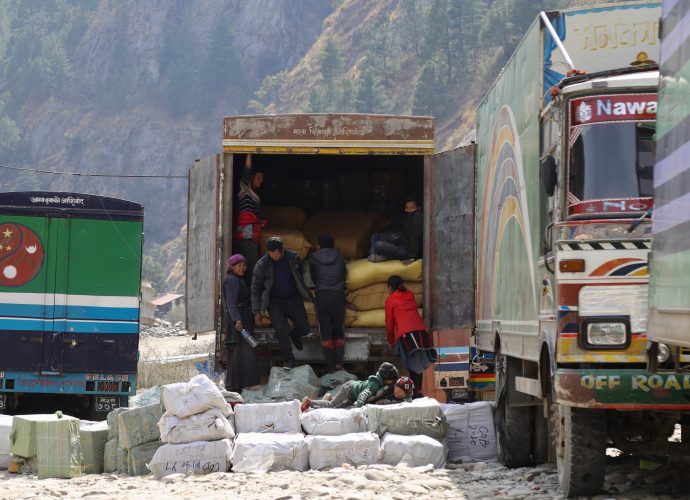
Porters unloading goods from a truck at Timure parking for customs clearance, Timure. In Timure, a large number of residents work in the parking area to load and unload imported goods from China that make it through customs. On a working day, hundreds of porters can be seen loading goods onto Nepalese trucks at the border. Depending on the season, a group consisting of five to six porters earn NRs 5000-8000 per day (roughly 44-70 $USD). According the residents, those working as porters at parking can earn between NRs 50,000-60,000 (roughly 445-530 $USD) during peaking season.
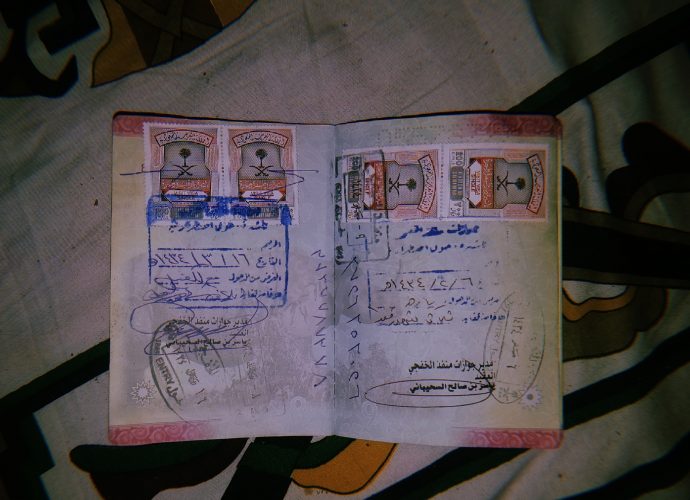
A Kuwait visa stamped passport of a Rasuwa resident, Rasuwa. In Rasuwa, a significant number of people have gone to the Gulf states for labor employment. Kuwait is one of the preferred destinations among women from Rasuwa, where many have gone and worked. Nevertheless, returnee labor migrants back in Rasuwa are often seen working as porters at Timure parking.
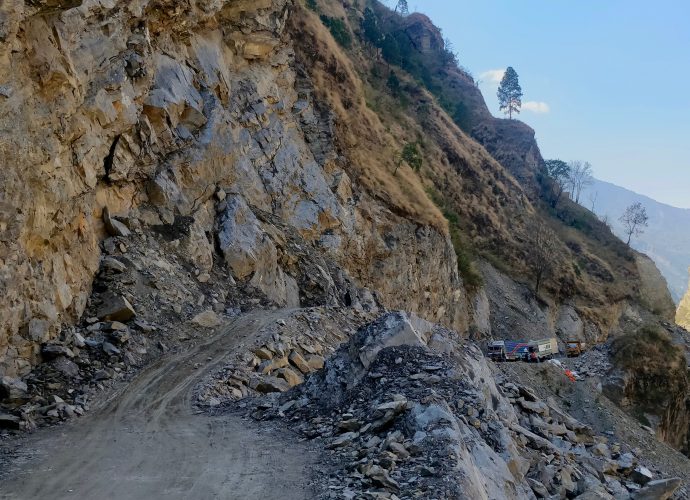
Recently opened Mailung-Sybrubesi section of the Galchi-Betrawati-Mailung-Sybrubesi road, Rasuwa. Considering the geologically challenging terrain, and its perennial disruption due to landslides during monsoon, the Nepal Army was contracted to open the Mailung-Sybrubesi road to shorten the distance to Rasuwagadhi by 24 kilometers. However, since the official opening of the new road in May 2018 – and despite much national publicity - the Mailung-Shyabrubesi has remained closed to both freight trucks and passenger jeeps for a large part of the year.

Only check post along Mailung-Sybrubesi road, Rasuwa. A journey to Rasuwagadhi will require encounters with at least a half-dozen security check posts staffed variously by Nepal Police, Armed Police Force, and the Nepal Army. The army check posts, also located in national parks throughout Nepal, are particularly known to be strict as they search for contraband wildlife products in and around Langtang National Park. Delays in setting up such check points along the Mailung-Sybrubesi is partly cited as a reason for the incomplete ‘opening’ of the Mailung-Syabrubesi road.

The reception wall of a hotel in Ghattekhola, Rasuwa. With an increasing number of Mount Kailash yatri (Nepali. pilgrims), particulalry from India, the hotels along the road have become more profitable. This is a wall of a hotel in Ghattekhola. Often, Indian Kailash yatri have to wait a day or two in Rasuwa to get their visa before entering into Tibet Autonomous Region, China to commence the yatra (journey).
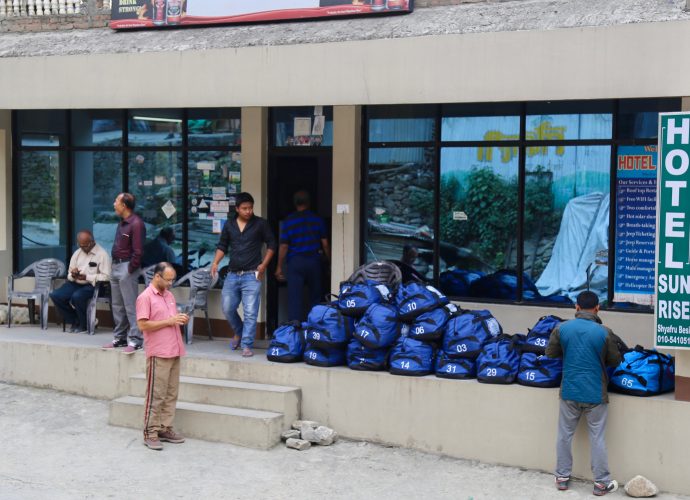
Indian Kailash yatri at Sybrubesi Bazaar, Rasuwa. Since 2018, Indian pilgrims headed to Mount Kailash have increasingly chosen the Rasuwagadhi-Kerung route in Rasuwa, as opposed to the Hilsa route in Humla district in western Nepal). In spring 2018 during our visit to Rasuwa, the majority of hotels between Ghattekhola and Dunchhe were occupied with Indian pilgrims. The growing numbers of Kailash yatri passing through has resulted hoteliers serving Indian dishes for the first time; until recently they have been serving Nepali and continental foods to trekkers and tourists.
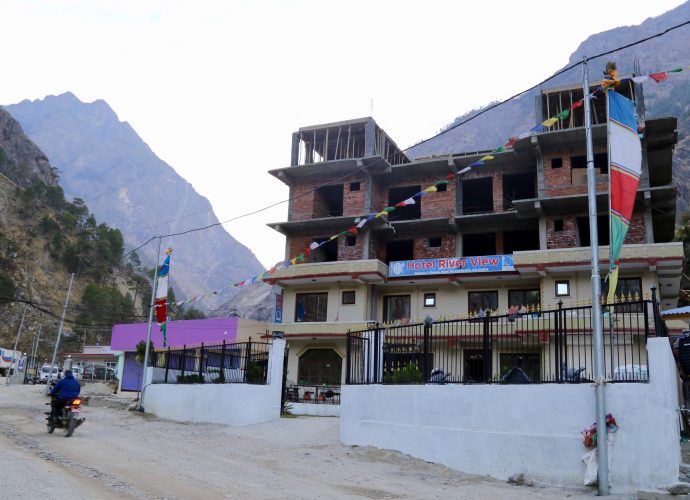
Upgrade of a hotel in Ghattekhola, Rasuwa. In Rasuwa, especially in Timure and Ghattekhole, the number of hotels are mushrooming, and older ones are being upgraded to accommodate more visitors traveling the route.
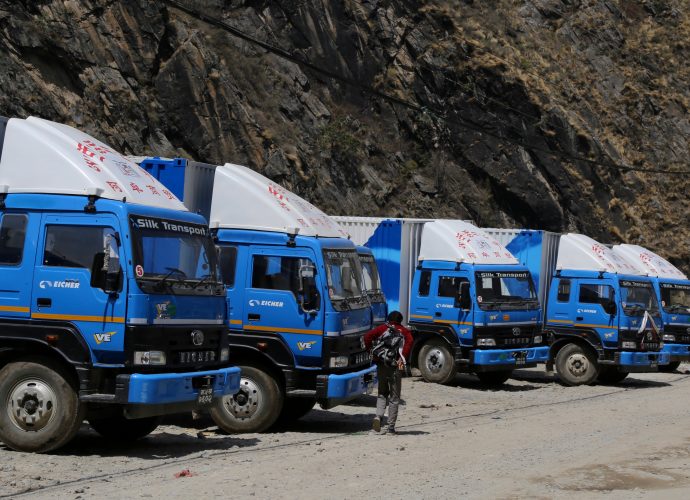
A new player - Silk Transport trucks parked at Ghattekhole, Rasuwa. During our second visit to the region, we saw a new transportation company named Silk Transport, which had brought in 38 trucks under their banner. The entry of Silk Transport has changed the transportation business by offering transportation cost to Kathmandu at least by 20% less than the existing rates from Kerung. In speaking with residents of Timure, we were informed that Silk Transport has planned to increase their truck number to 200 within the next year as a part of its expansion, which is likely to dominate the transportation business along this corridor.
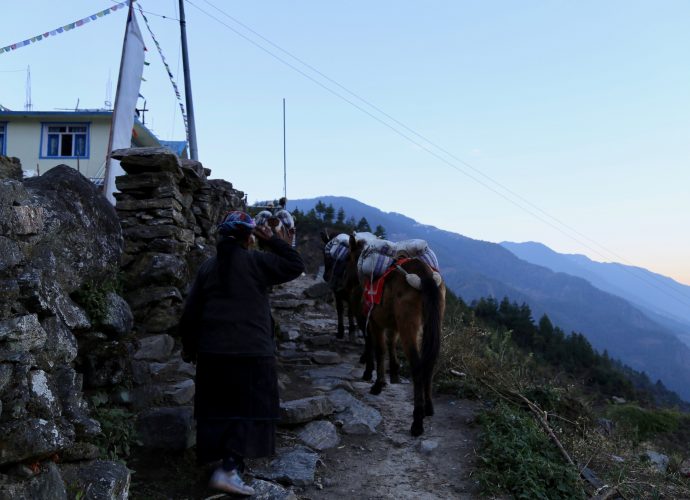
A mule caravan passing north to Langtang valley from Khanjim, Rasuwa. Langtang valley remains one of the only areas within Rasuwa district where road connectivity is absent, and the transportation of basic household provisions and consumer goods are still transported on draught animals such as mules and horses.
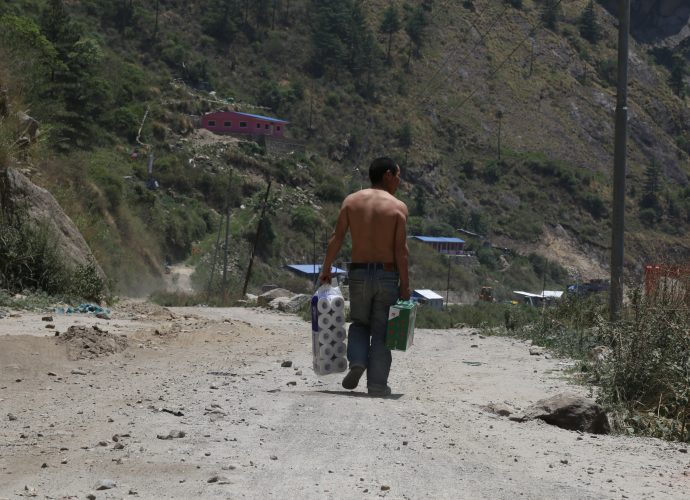
A Chinese worker carrying toilet paper and a box of Lhasa beer to Rasuwagadhi hydropower construction site, Rasuwa. A sizable number of Chinese workers are employed at the hydroprojects in Rasuwa, where they are considered more skilled than Nepalese workers who work alongside them. Unsurprisingly, the residents say the pay gap between the Chinese and Nepalese is quite high, with Nepali workers receiving far less compensation than their Chinese counterpart.
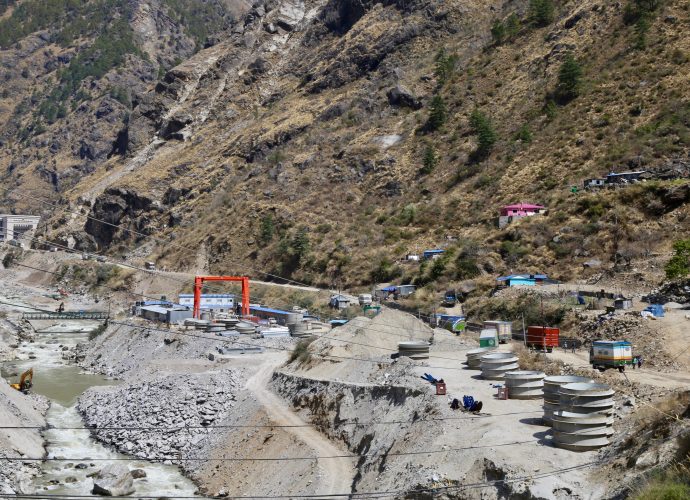
Rasuwagadhi hydropower project, Ghattekhola, Rasuwa. The headquarter of the Rasuwagadhi hydropower plant is located about 400 meters downstream from the Rasuwagadhi border point, at the confluence of the Kyirong Khola and Lende Khola. It is the northern most hydropower project in Rasuwa, located in close proximity to China. This run-of-the-river hydro project aims to generate 613 gigawatt hours of hydroelectricity annually. A Chinese company named China International Water and Electric Corporation is contracted for completing this project.
by Nyima Dorjee Bhotia & Phurwa Dhondup Gurung
Rasuwa district has historically been a strategic Himalayan frontier where one of the two major border crossings between Nepal and the Tibetan Autonomous Region, China, is located. This route was a central locus for military campaigns on multiple occasions, and a key passage for trans-Himalayan traders, pilgrims, artisans, and religious teachers for a long time[1]. When China built the Araniko highway through Kodari in the 1960s, Rasuwa fell into shadow as the volume of trade and other mobilities concentrated in the Kodari border crossing in Sindupalchowk. However, Rasuwa’s “backwater” status has dramatically reversed since the 2015 Nepal earthquake when China shut down the Kodari border crossing and evacuated its citizens from Zhangmu to the nearby town of Shigatse. Although activities in the Kodari region have slowly resumed and the border was triumphantly reopened at the end of May 2019, movement across this border has been negligible since[2]. This appears due in large part to China’s priority of the Rasuwa border over Kodari, a position that has been historically consistent[3]. The Rasuwa border, then, is considered a “key locus and first point of entry for China in South Asia.”[4]
Rasuwa has thus seen significant infrastructural development, trade, and other cross-border traffic of people and commodities in recent years. Talks of ambitious geopolitical and geoeconomic projects abound, especially in the wake of Chinese President Xi Jingping’s visit to Nepal in October 2019, including a trans-Himalayan railway as a part of China’s Belt and Road Initiative[5]. Despite these recent highlights, it’s worth noting that the construction of the first roads in the region can be attributed to the development of hydroelectric projects. In particular, the construction of the Trishuli hydropower station in 1967 by the governments of Nepal and India connected the district headquarters, Dunche, to Kathmandu, and the construction of Chilime hydropower further extended road network to parts of northern Rasuwa. Contrary to arguments that emphasize the geopolitics of roads, we suggest that roads were primarily built and continue to facilitate local resource and labor extraction, hydropower construction (e.g., Trishuli and Chilime), and mining (e.g., Somdang zinc mine) in particular in Rasuwa.
This photo essay offers a visual glimpse into how infrastructure development in Himalayan borderlands transform these otherwise ‘peripheral’ regions into major geopolitical and geoeconomic hotspots. Photos show the dramatic makeover of transportation and bureaucratic infrastructure, including a major dry port and customs office in Rasuwagadhi, the mushrooming of secondary markets including local eateries and banking institutions, new geographies of labor and old dynamics of trades, emerging transportation enterprises, and construction of the new Mailung-Syabrubesi road. We are particularly struck by the ways in which locals of Rasuwa are marginalized within these emerging assemblages of infrastructures, trade, labor and transportation. For instance, construction of the dry port at Timure attracts a large number of locals from surrounding villages like Timure and Thuman for extremely low wage, potentially dislocating them from their livelihood and place. Traders who operated in the Kodari border before the earthquake have moved posts and now dominate major trades in Rasuwa, marginalizing Rasuwa traders within the burgeoning border trade. At the same time, big actors like Silk Transport have entered the scene. Silk Transport, a transportation company that currently owns 38 trucks, is set to increase the number of trucks to 200 within the next few years and dominate transport enterprise in this major border crossing between China and Nepal. Although better off families have been able to make do by opening small scale lodges, shops, or investing in transportation enterprises, a large majority of Rasuwa locals grapple with the unevenness of infrastructure development and the associated effects. These emergent, localized political economies of roads challenge the false rhetoric of development[6] and market triumphalism pervasive in media and geopolitical discourses that represent the region.

Map by Rupak Shrestha
Nyima Dorjee Bhotia is a Research Associate at Social Science Baha.
Phurwa Dhondup Gurung studies Geography at the University of Colorado Boulder.
[1] Cowan, Sam. 2013. All Change at Rasuwa Garhi. HIMALAYA 33(1): 97-102.
[2] China’s focus on Rasuwagadhi-Kerung puts Tatopani-Khasa border in the shadows. The Kathmandu Post. August 10, 2019.
[3] Cowan, Sam. 2013. All Change at Rasuwa Garhi. HIMALAYA 33(1): 97-102.
[4] Murton, Galen, Austin Lord, and Robert Beazley. 2016. A Handshake Across the Himalayas:” Chinese Investment, Hydropower Development, and State Formation in Nepal. Eurasian Geography and Economics 57(3): 403-432..
[5] List of deals between Nepal and China during visit of Chinese President Xi Jingping. Republica. October 13, 2019
[6] See Campbell, Ben. 2010. Rhetorical Routes for Development: A Road Project in Nepal. Contemporary South Asia 18(3): 267-279.
